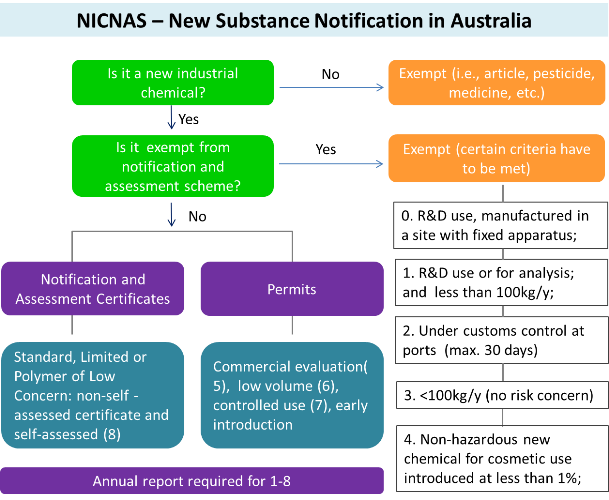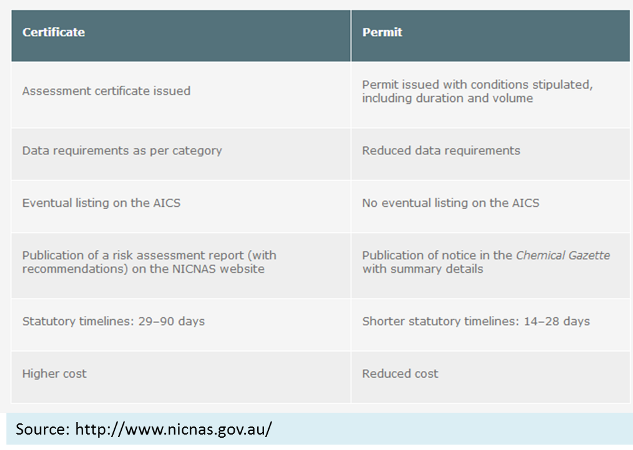The National Industrial Chemicals Notification and Assessment Scheme, known as NICNAS, was established in 1990 under the Industrial Chemicals (Notification and Assessment) Act 1989 with the purpose of protecting workers, the public and the environment from the harmful effects of industrial chemicals.
NICNAS assesses industrial chemicals that are new to Australia for their health and environmental effects before they are introduced to Australia. All new industrial chemicals (i.e. those not listed on AICS) must be notified to NICNAS and assessed prior to their import or manufacture in Australia unless they are exempt.
NICNAS also assesses some priority existing chemicals (PECs) that are already in use in Australia. Companies who introduce PECs to Australia shall also apply for the assessment. If you export chemicals to Australia, you shall check if they contain any new substances or PECs first.
Scope of NICNAS
NICNAS excludes articles (such as plastic chairs and photographic film) and radioactive chemicals. Chemicals that are used solely as medicines, pesticides, veterinary chemicals, food or food additives are not regarded as industrial chemicals and are outside the scope of NICNAS. For a mixture (i.e., cosmetic), NICNAS applies to individual substances in it.
Main Requirements of NICNAS
| Requirements | Notes |
|---|---|
| Business Registration |
|
| New Chemical Notification |
|
| Annual Report |
|
| Assessment of Priority Existing Chemicals (PECs) |
|
NICNAS Registration of Businesses
All importers and/or manufacturers of industrial chemicals for commercial purposes are required to register with NICNAS regardless of the amount of industrial chemicals imported and/or manufactured in that registration year. The registration year runs from 1 September to 31 August in the following year. Please be noted that this is business registration, not substance or product registration.
Registration involves paying an annual registration fee and a registration charge, which varies according to the value of the chemicals manufactured or imported.
New Chemical Notification under NICNAS and Exemptions
A new chemical substance is an industrial chemical that is not listed on the Australian Inventory of Chemical Substances (AICS), or is a listed chemical substance subject to a condition of use. Only domestic manufacturers and importers can submit new substance notifications to NICNAS.
The following new chemical substances are exempt from notification and assessment:
- Manufactured in Australia in the course of a program of research, development and analysis (advice of introduction needs to be submitted to NICNAS);
- Imported to Australia solely for research, development and analysis with quantity less than <100kg/y (*);
- At ports subject to the control of Customs (max 30 days) *;
- Posing no unreasonable risk and quantity less than <100kg/y (*);
- Non-hazardous and introduced in a cosmetic with a concentration less than 1% (*);
- (*): Annual report is required ;
The picture below shows how to determine if a new chemical substance requires notification under NICNAS.

Types of Approvals for New Chemical Substances
For those new substances which do not qualify for exemptions, you may apply for two different types of approvals: certificates or permits. The table below summarizes different types of certificates or permits you can apply for a new chemical substance.
| Commercial Evaluation Permit (CEP) |
|
| Low Volume Permit (LVP) |
|
| Controlled Use Permit (CUP) |
|
| Polymer of Low Concern (PLC) Certificate |
|
| Limited Notification Certificate (LTD) |
|
| Standard Notification Certificate (STD) |
|
| Early Introduction Permit (EIP) |
|
Detailed data requirements for new chemical notification can be found here. The picture below given by NICNAS compares the differences between a certificate and a permit.

Self-assessment vs Non-self-assessment
For PLCs or non-hazardous substances (substances of low regulatory concern), a notifier can self-assess them against specified criteria and provide an assessment report which is screened and amended by NICNAS in consultation with the notifier before publication. The self-assessment time frame (28 days) is much shorter than for non-self-assessment category (90 days). Fee is also lower. In this case, annual report is required.
Annual Report
A person who introduces a new industrial chemical in a registration year under circumstances 1 to 8 (see picture 1) must provide a report to NICNAS stating the name of the chemical, its volume and adverse effects found. The report must be provided before or on 28 September of the following year.
Priority Existing Chemicals (PECs)
A PEC is an industrial chemical for which NICNAS requires investigation in detail because of its potential risks to human health or the environment. A person must not introduce a priority existing chemical to Australia unless an assessment certificate has been applied for.
Where a chemical becomes a priority existing chemical, a person may, within 28 days, apply in writing for the assessment of the chemical. Where the chemical has been a priority existing chemical for longer than 28 days, the person may make a late application. If no application is lodged after a chemical is declared a PEC, the NICNAS Director can request an assessment report be started at any time within 12 months.
The Director may also require relevant persons to supply information required for the PEC assessment. Required info includes hazard properties, test reports, volume, uses, info on downstream users and conditions related to manufacture, handling and storage.
From July 2012, NICNAS began assessing around 3,000 priority existing chemicals. In addition to that, NICNAS has drawn up a candidate list of chemicals to consider declaring as PECs. You can find out if an existing chemical substance is a PEC or candidate PEC or not on AICS.
NICNAS Assessment Reports
If a notification is made under a certificate category, an assessment report will be published on NICNAS's website containing a summary of health, safety and environmental matters considered in the assessment and such recommendations as may reasonably be made to ensure safe use of the chemical. These reports can be access here.
No comments:
Post a Comment